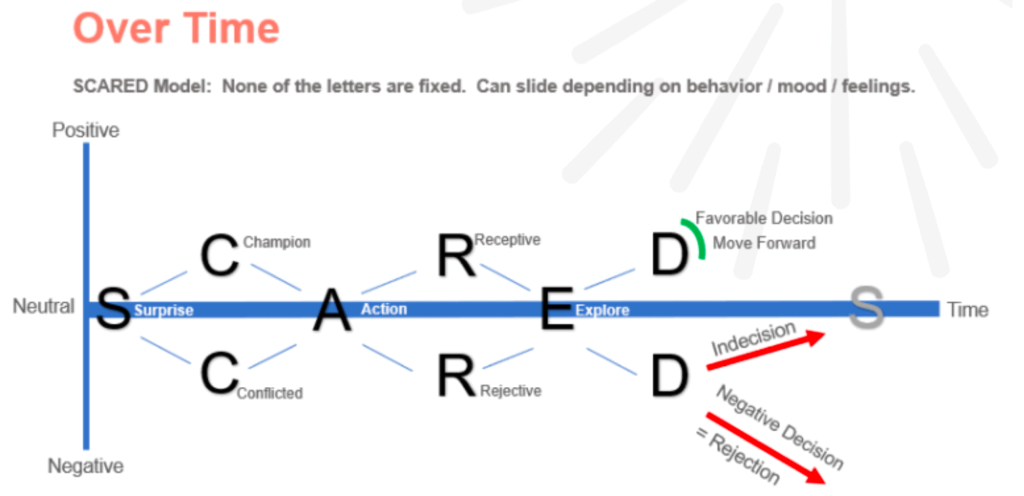Leaders often implement change. This point is evident from the USD 2.7 trillion market value of digital transformation in 2023.
But how often do leaders ask their employees, the ones carrying out the change, how they feel about it?
Personal transformation in change is essential because individuals make up every organization, and change is a complex emotional experience, especially because change management in the age of disruption is so commonplace today.
By engaging with change personally, Dr. Van Ulbrich, writer of Transforming Sales Management: Lead Sales Teams Through Change, helps individuals gain the confidence to go through the emotional stages of change.
They can then come out the other end of their change experience more confident and willing to approach their leaders to begin a dialogue about their true feelings about change.
Personal transformation in change can also support leaders to understand the emotional process of change for their employees and consider how to adjust changes based on employee feedback.
The heart of this method is the Scared So What change model, the principles set out in a recent podcast: Learning to manage personal change with Scared So What with Dr. Ulbrich.
It’s also essential to consider what this change model looks like and how to implement it. Doing so will allow us to understand why personal transformation in change matters in large change initiatives.
Why is personal transformation significant to large change initiatives?
Leaders usually don’t ask their team members how they feel about change. As a result, staff members can feel left out of the loop when leaders make decisions, which can build resentment.
When researching his new change model, Scared So What, Dr. Van Ulbrich asked many leaders, “As a leader, do you ever ask your employees if they support the changes you impose?” The answer was usually no.
Leaders do not ask their employees how they feel about change when staff members carry out the changes for their organization.
Personal transformation is essential to the success of significant change initiatives in enterprises because it supports employees in discussing their feelings on change with their leaders and helps leaders understand how employees process change. As Dr. Ublrich says, “If you don’t include the individual, you can count on poor to mediocre results.”
Dr. Ulbrich adds, “Organizational change cannot continue without the individual.” This understanding can encourage leaders to seek out employees’ views, build a dialogue, and help them feel more positive about change.
This environment leads to higher staff well-being and a culture that encompasses more positive attitudes toward change. This culture leads to better change initiative outcomes and faster ROI for digital transformations.
What are the steps of personal transformation for change?

https://oxford-review.com/personal-change-model/
We know change is the only constant in life, but it can be challenging to work out how to navigate it successfully as we do not receive knowledge on how to navigate change as we develop into adults. The Scared So What change model provides four steps to help people process change personally.
The creator of this change model, Dr. Van Ulbrich, describes the model as encouraging people to ask themselves: “You’re scared. What does that mean? Assess your feelings, reflect, and make action points to move forward and make an informed decision about how to proceed.”
The six steps of the Scared So What change model for personal transformation (SCARED) are:
- S: Surprise – Change is initially a surprise for everyone, no matter how well others might try to help us prepare. The surprise of change initiates the emotions that follow.
- C: Champion or Conflicted? – The change recipient quickly decides to become a champion of change or may be conflicted about their feelings toward change.
- A: Action – The person experiencing change must take action to express their feelings about change.
- R: Receptive/ rejective – The change recipient becomes receptive and accepts the change or rejects it.
- E: Explore – Next comes the opportunity to explore feelings about change. This stage is essential because it determines whether the final stage is positive or negative.
- D: Favorable decision/ indecisive – If the decision about how someone feels about change is clear, the change recipient can move forward following dialogue with colleagues or leaders in an enterprise setting. If the Explore stage goes poorly, it will lead to indecision and complicated and often negative feelings about change.
Individuals should try this method to overcome change. In an enterprise setting, both leaders and employees can use it to process changes.
Employees can use the SCARED method to process changes, and leaders can try it for personal experiences of change to understand what their team members experience every time they implement changes as leaders.
The model seeks to help anyone understand changes and create a more effective dialogue through increased empathy.
This method helps staff process change and become more likely to engage healthily. The outcome is that staff will carry out the change or approach leaders constructively to communicate the challenges they experience with change and ways to adjust and review them.
Whatever form personal transformation takes, the Scared So What change model and the accompanying app are at the heart of it. They can lead to better change initiative outcomes as they increase understanding of change and faster ROI.







